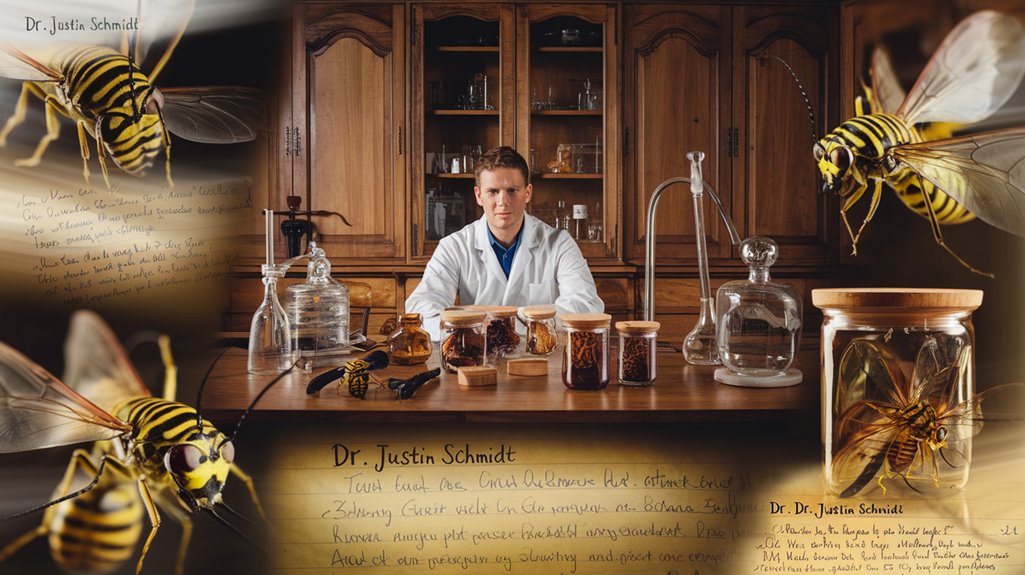The Scientist Who Tested Lethal Stings on Himself
Like Prometheus enduring eternal punishment for the sake of humanity's advancement, you'll find Dr. Justin Schmidt's story equally compelling and sacrificial. You've probably never wondered what it feels like to be stung by a tarantula hawk wasp or a bullet ant, but this dedicated entomologist has experienced both—along with more than 1,000 other insect stings. His voluntary encounters with nature's most painful defenders have revolutionized our understanding of venom and created an unprecedented scientific legacy worth exploring.
Meet Dr. Justin Schmidt: The Man Behind the Stings

A passionate entomologist with an unusual approach to research, Dr. Justin Schmidt turned his chemistry background into a groundbreaking career studying insects.
You'll find his entomological passion rooted in his early years in Pennsylvania, where his father's work as a forester likely influenced his connection to nature. After realizing chemistry lacked the "living, moving" elements he craved, he pursued advanced degrees in entomology. During his research missions, Schmidt and his wife Debbie collected numerous insects for their venom studies.
From 1980 to 2005, you'd find Schmidt at the Carl Hayden Bee Research Center in Tucson, where he dedicated himself to studying the biochemistry of insect venom. He later died in 2023 from complications of Parkinson's disease.
His unique willingness to experience stings firsthand led to the creation of the famous Schmidt Sting Pain Index. This hands-on approach earned him the nickname "King of Sting" and worldwide recognition in his field.
The Birth of the Schmidt Sting Pain Index
While studying the relationship between pain and insect sociality, Dr. Schmidt developed his groundbreaking pain measurement system in 1983.
You'll find his scale elegantly simple, ranging from 1 to 4, with vivid descriptions that help you understand the intensity of each sting.
What makes this index remarkable isn't just its creative pain descriptions – like comparing a Level 1 sting to an overzealous love bite – but its deeper scientific purpose.
Schmidt wanted to understand how venom toxicity and pain influenced the evolution of social behavior in Hymenoptera.
The venom of small bees contains polypeptides like melittin, creating the mild sensations characteristic of Level 1 stings.
Multiple stings can have devastating effects on small animals, as four honey bee stings can be lethal to a mouse.
You'll see this reflected in the scale's structure, where the highest rating of 4 is reserved for truly extraordinary stings from insects like the bullet ant and tarantula hawk.
His work earned him the Ig Nobel Prize and continues inspiring research into pain mechanisms today.
From Lab to Field: A Journey Through Pain
Schmidt's dedication to understanding insect stings went far beyond creating a simple pain scale. You'll find that his research involved meticulous venom extraction processes and firsthand experiences with over 1,000 stings from nearly 100 different species.
His pain tolerance was put to the ultimate test as he dissected and even tasted bee parts to comprehend how predators might detect their prey. By holding his breath, Schmidt discovered that approaching killer bees without triggering aggression was possible. Like Yanagihara's groundbreaking research, he developed new extraction methods for studying insect venom.
His field work revealed fascinating discoveries, like yellow jackets' ability to spray venom rather than just sting. Through careful observation, he noted how kingbirds could distinguish between male and female bees mid-flight, suggesting complex predator-prey relationships.
Despite the risks involved, similar to those faced by scientists like Daghlian and Slotin, Schmidt's hands-on approach has provided invaluable insights into the world of venomous insects.
Ranking Nature's Most Painful Defenders
Through decades of meticulous research, scientists have identified and ranked nature's most formidable defensive weapons, from the nerve-searing sting of the Japanese Giant Hornet to the lasting torment of the Gympie-Gympie plant.
When you examine insect pain, you'll find the Schmidt Sting Pain Index offers a systematic way to compare these natural weapons. Dr. Sam Robinson documents each sting with detailed pain notes while using a stopwatch to track duration. The Japanese Giant Hornet tops the charts with its intense venom mechanisms, while the Bullet Ant follows closely behind.
You might be surprised to learn that the Tarantula Hawk Wasp's sting ranks among the most excruciating, though it's shorter in duration than some others. Like the notorious defender Chopper Harris, these creatures have earned reputations that make others avoid confrontation at all costs.
Recent studies of venom composition and neurotoxins have revolutionized our understanding of how these creatures inflict pain, leading to groundbreaking insights in both defensive strategies and potential medical applications.
Life-Changing Discoveries in Venom Research

These painful stings that nature's creatures use for defense have led scientists to an unexpected treasure trove of medical breakthroughs.
You'll find venom applications transforming modern medicine, from treating heart attacks to managing diabetes. The most promising development comes from funnel-web spider venom, where a groundbreaking drug called Hi1a could revolutionize heart transplant surgery by 2024.
Dr. Steve Mackessy's research at MVAL laboratory has been instrumental in analyzing snake venoms for over three decades.
The Hi1a protein works by blocking acid channels that trigger cell death after heart attacks.
You're witnessing incredible medical breakthroughs as researchers harness venoms from various species.
Snake venom compounds are showing potential in fighting cancer spread, while rattlesnake toxins might limit cancer metastasis.
Scientists are even developing synthetic antibodies for a universal antivenom solution.
Through innovative techniques like mass spectrometry and global collaboration, researchers are revealing these toxic cocktails' therapeutic potential, turning deadly weapons into life-saving medicines.
 mind-brain interactions to revolutionize how we understand and treat persistent pain conditions.
mind-brain interactions to revolutionize how we understand and treat persistent pain conditions.
The discovery of opioid receptors in 1972 laid crucial groundwork for modern pain management strategies.
In parallel, research into insect resistance is evolving rapidly.
You're seeing remarkable developments in how plants defend themselves against insect attacks through jasmonic acid pathways and induced resistance mechanisms.
Scientists are now combining these insights from both fields – studying how venoms affect pain pathways while exploring natural defense systems.
This intersection of pain science and insect defense studies might lead you to groundbreaking discoveries in pain management and crop protection strategies.










